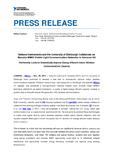National Instruments (Nasdaq: NATI) and the University of Edinburgh have partnered to develop a test bed to dramatically improve indoor wireless communications capacity. Professor Harald Haas, lead researcher at Edinburgh and featured NIDays UK speaker, has pioneered a next-generation massive multiple input, multiple output (MIMO) technique, referred to as spatial modulation, to power a highly energy efficient capacity increase in another step on the path toward fifth-generation (5G) wireless communications.
Haas and Professor Cheng-Xiang Wang, head of the Advanced Wireless Technologies Lab at Heriot-Watt University, recently used NI PXI Express hardware and NI LabVIEW system design software to create the first working prototype showing spatial modulation techniques over a wireless RF channel. In a live TED Talk in 2011, Haas demonstrated a concept, nicknamed LiFi, using visible light communication over a single-channel, point-to-point link. He now plans to combine these technologies to create even higher density optical wireless networks-called optical attocell networks-that will harness massive MIMO gains in both the optical and RF domains for energy-efficient indoor wireless communications.
“We-ve known for a long time that decreasing cell size can significantly increase cellular capacity and user data rates, but it-s not been clear how we could facilitate that given current spectrum, energy and interference limitations,” said Haas. “RF wireless and optical wireless networks that work together using spatial modulation and massive MIMO approaches could allow us to effectively mitigate interference and significantly increase energy efficiency, coverage and capacity using existing infrastructure.”
The Edinburgh team is extending its research capabilities with the LabVIEW reconfigurable I/O (RIO) architecture for rapid prototyping. Using the NI FlexRIO Software Defined Radio Bundle with reconfigurable FPGAs and interchangeable I/O adapter modules, the team is building prototypes that operate beyond the rates of a commercial RF wireless system. The team recently achieved 3.5 Gbit/s from a single color LED, allowing them to create an ultra-realistic test bed.
“We are excited to collaborate with Professor Haas, who has been pioneering visible light communications and spatial modulation for nearly a decade,” said Erik Luther, Wireless Communications Group Manager at NI. “Through the LabVIEW RIO architecture, Haas can rapidly prototype a first-of-its-kind wireless test bed.”
Learn more about the National Instruments software defined radio platforms that are driving next-generation wireless systems.
Since 1976, National Instruments (www.ni.com) has equipped engineers and scientists with tools that accelerate productivity, innovation and discovery. NI-s graphical system design approach provides an integrated software and hardware platform, speeding the development of any system needing measurement and control. NI ensures customer success with an ecosystem of services, support and more than 700 Alliance Partners worldwide. The company-s long-term vision and focus on improving society through its technology also enables the success of its employees, suppliers and shareholders.


You must be logged in to post a comment Login